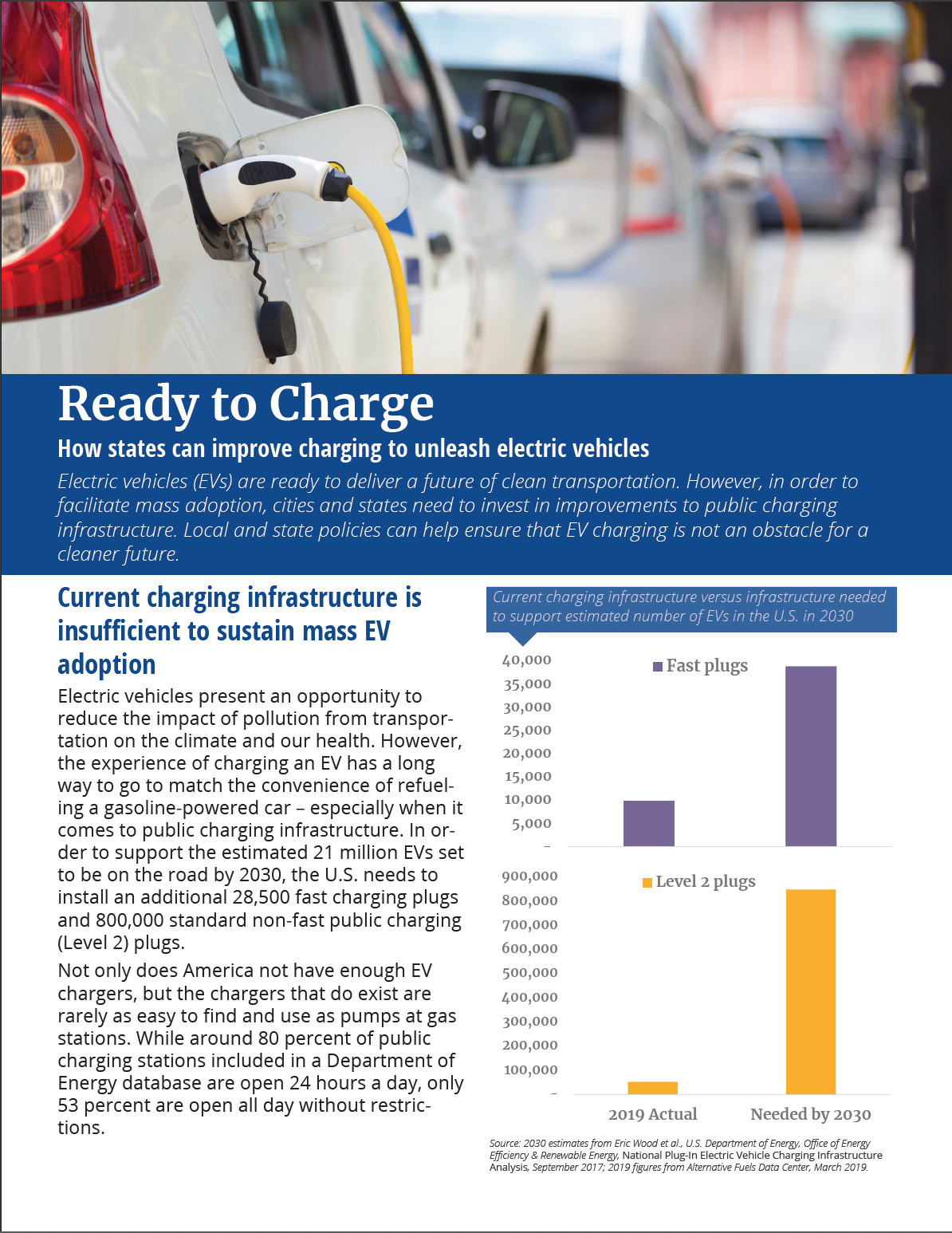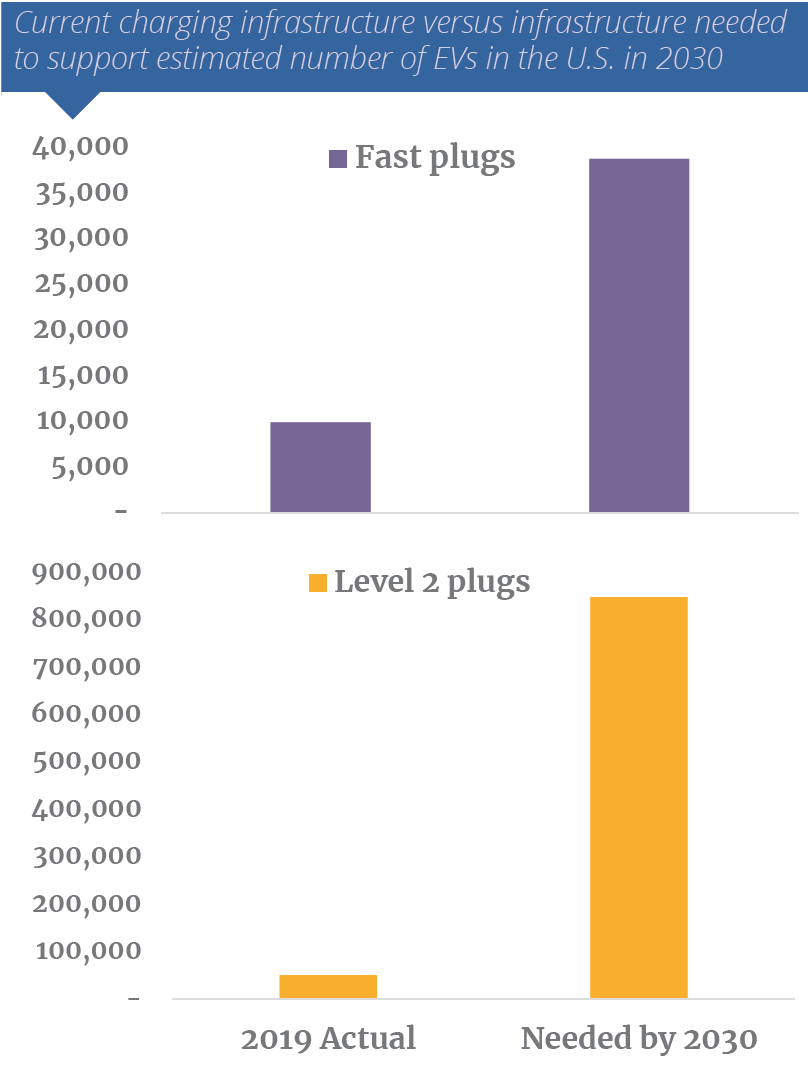Ready to Charge Factsheet
How states can improve charging to unleash electric vehicles
Electric vehicles (EVs) are ready to deliver a future of clean transportation. However, in order to facilitate mass adoption, cities and states need to invest in improvements to public charging infrastructure. Local and state policies can help ensure that EV charging is not an obstacle for a cleaner future.

Downloads
Electric vehicles (EVs) are ready to deliver a future of clean transportation. However, in order to facilitate mass adoption, cities and states need to invest in improvements to public charging infrastructure. Local and state policies can help ensure that EV charging is not an obstacle for a cleaner future.
Current charging infrastructure is insufficient to sustain mass EV adoption
Electric vehicles present an opportunity to reduce the impact of pollution from transportation on the climate and our health. However, the experience of charging an EV has a long way to go to match the convenience of refueling a gasoline-powered car – especially when it comes to public charging infrastructure. In order to support the estimated 21 million EVs set to be on the road by 2030, the U.S. needs to install an additional 28,500 fast charging plugs and 800,000 standard non-fast public charging (Level 2) plugs.
Not only does America not have enough EV chargers, but the chargers that do exist are rarely as easy to find and use as pumps at gas stations. While around 80 percent of public charging stations included in a Department of Energy database are open 24 hours a day, only 53 percent are open all day without restrictions.

Source: 2030 estimates from Eric Wood et al., U.S. Department of Energy, Office of Energy Efficiency & Renewable Energy, National Plug-In Electric Vehicle Charging Infrastructure Analysis, September 2017; 2019 figures from Alternative Fuels Data Center, March 2019.
Policies can help promote EV adoption
EV drivers should have the same access to affordable, easy-to-use and convenient refueling as drivers of gasoline-powered vehicles. Public policy decisions can help make that possible. To encourage mass adoption of electric vehicles, cities and states should:
Expand public charging capacity.
- Build charging plugs on public property like the parking lots of government buildings and schools, and on curbsides.
- Make EV charging a part of new commercial, residential and municipal development by requiring a certain percentage of parking spaces to have the infrastructure to support EV charging.
- Enable residents to install on-street charging infrastructure on curbsides, especially in dense neighborhoods where people rely on on-street parking overnight.
Make EV chargers more accessible by increasing interoperability.
- Require that charging stations built with public funds are accessible to consumers with different vehicle and plug types. Currently, certain chargers are not usable by some types of cars, with some fast-charging plugs (CHAdeMO) only working for Asian cars, others (SAE Combo) working on European and American cars, and Tesla’s proprietary connection only working on Teslas.
- Require public chargers to be open to all users without a membership to a charging network. Currently, more than 10 charging networks operate throughout the U.S., all with their own apps and memberships, making EV charging a hassle for drivers.
- Standardize fee structures and pricing metrics. Right now, some stations charge flat fees, some charge based on amount of electricity used, and others charge by length of time charging. The variation and lack of clear markings can leave drivers guessing how much they will end up paying.
- Require charging stations to accept credit cards, ATM cards or other forms of electronic payment.
Increase the visibility and price transparency of public charging stations.
- Require more visible signage – like the signs at gas stations – that can help drivers identify the location of charging stations.
- Promote price transparency at charging stations – similar to dollar-per-gallon displays at gas pumps – which can help consumers feel more informed and comfortable with public charging for their EVs.
- Require open data from companies receiving public funding or installing stations in public spaces, enabling app developers to provide this information to the public. This can help drivers find available chargers, and provide policymakers with information about where to improve infrastructure.
Ensure EV spaces are open for EVs.
- Enact and enforce penalties for non-electric vehicles occupying charging locations.
- Set time limits on the use of EV parking spaces and charge idle fees for cars not actively utilizing a charging space’s plug.
Expand access to other forms of electric mobility.
- Promote other clean modes of transportation like EV carsharing and ridesharing, electric buses and electric bikes in order to encourage clean travel without requiring EV ownership.
